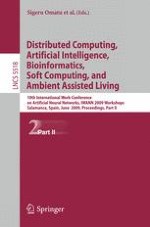This volume (II) contains all publications accepted for the symposiums and workshops held in parallel with the 10th International Work-Conference on Artificial Neural Networks (IWANN 2009), covering a wide spectrum of technological areas such as distributed computing, artificial intelligence, bioinformatics, soft computing and ambient-assisted living: • DCAI 2009 (International Symposium on Distributed Computing and Artificial Intelligence), covering artificial intelligence and its applications in distributed environments, such as the Internet, electronic commerce, mobile communi- tions, wireless devices, distributed computing, and so on. This event accepted a total of 96 submissions selected from a submission pool of 157 papers, from 12 different countries. • IWAAL 2009 (International Workshop of Ambient-Assisted Living), covering solutions aimed at increasing the quality of life, safety and health problems of elderly and disabled people by means of technology. This event accepted a - tal of 42 submissions selected from a submission pool of 78 papers, from 9 d- ferent countries. • IWPACBB 2009 (Third International Workshop on Practical Applications of Computational Biology and Bioinformatics), covering computational biology and bioinformatics as a possibility for knowledge discovery, modelling and - timization tasks, aiming at the development of computational models so that the response of biological complex systems to any perturbation can be p- dicted. This event accepted a total of 39 submissions selected from a subm- sion pool of 75 papers, from 6 different countries.
